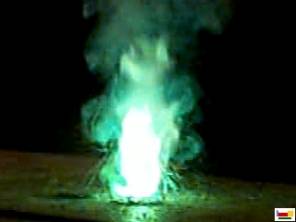
Barium

The picture above shows the result of adding different metal salts to a burning reaction mixture of potassium chlorate and sucrose. The red color originates from strontium sulfate. The orange/yellow color originates from sodium chloride. The green color originates from barium chlorate. The blue color originates from copper (I) chloride. The lilac color that should be evident from the potassium chlorate is washed out by the other colors, all of which are more intense.
Description
History
Density
Melting Point
Boiling Point
Electronegativity
Ground State Electron Configuration
Common Oxidation States
Crystal Structure
Naturally Occurring Isotopes
Medical
Industrial
Miscellaneous
Source
Price Per Gram
 (Dr.
Bean)
(Dr.
Bean)
Description:
Name: Barium
Symbol: Ba
Atomic Number: 56
Atomic Mass: 137.327 amu
Atomic Structure:
|
|
|
|
History:
Date of Discovery:
1808
Discoverer: Sir
Humphrey Davy
Name Origin: From the Greek word
barys (heavy)
Barium is a metallic element, soft, and when pure is silvery white like lead. The metal oxidizes very easily and it reacts with water or alcohol. Barium is one of the alkaline-earth metals.
Standard State: solid at 298 K
Color: silvery white
Density @ 293 K: 3.51 g/cm3
Melting Point: 725.0 °C (998.15 °K, 1337.0 °F)
Boiling Point: 1140.0 °C (1413.15 °K, 2084.0 °F)
Electronegativity: .89 (Pauling)
Ground State Electron Configuration:

Common Oxidation State: +2
|
Fluorides |
|
|
Chlorides |
|
|
Bromides |
|
|
Iodides |
|
|
Hydrides |
|
|
Oxides |
|
|
Sulfides |
|
|
Selenides |
|
|
Tellurides |
|
|
Nitrides |
|
Crystal Structure: body-centered cubic

Naturally Occurring Isotopes:
|
Isotope |
Atomic
mass (ma/u) |
Natural
abundance (atom %) |
Nuclear
spin (I) |
Magnetic
moment (m/mN) |
|
130Ba |
129.906282
(8) |
0.106 (1) |
0 |
|
|
132Ba |
131.905042
(9) |
0.101 (1) |
0 |
|
|
134Ba |
133.904486
(7) |
2.417 (18) |
0 |
|
|
135Ba |
134.905665
(7) |
6.592 (12) |
3/2 |
0.837943 |
|
136Ba |
135.904553
(7) |
7.854 (24) |
0 |
|
|
137Ba |
136.905812
(6) |
11.232
(24) |
3/2 |
0.937365 |
|
138Ba |
137.905232
(6) |
71.698
(42) |
0 |
|
Half-life of Isotopes:
|
Isotope |
Half Life |
|
Ba-130 |
Stable |
|
Ba-131 |
11.7 days |
|
Ba-132 |
Stable |
|
Ba-133 |
10.5 years |
|
Ba-133m |
1.6 days |
|
Ba-134 |
Stable |
|
Ba-135 |
Stable |
|
Ba-135m |
1.2 days |
|
Ba-136 |
Stable |
|
Ba-137 |
Stable |
|
Ba-137m |
2.6 minutes |
|
Ba-138 |
Stable |
I. Medical Applications: X-Ray Diagnostic Work
Example: Barium Enema
The test is used to detect colon cancer. The barium enema may also be used to diagnose and evaluate the extent of inflammatory bowel diseases.


This test may be done in an office or a hospital radiology department. You lie on the X-ray table and a preliminary X-ray is taken. You are asked to lie on the side while a well lubricated enema tube is inserted gently into your rectum. The barium, a radiopaque (shows up on X-ray) contrast medium, is then allowed to flow into the colon. A small balloon at the tip of the enema tube may be inflated to help keep the barium inside. The flow of the barium is monitored by the health care provider on an X-ray fluoroscope screen (like a TV monitor). A barium enema, or lower gastrointestinal (GI) series, uses x-rays to diagnose problems in the large intestine, which includes the colon and rectum. The lower GI series may show problems like abnormal growths, ulcers, polyps, and diverticuli.

II. Industrial Applications:
a. Glass Making

b. Barite is extensively used as a weighting agent in oil well drilling fluids.
c. Barite is also used in making rubber

III. Miscellaneous:
a. The carbonate is a rat poison

b. The nitrate and chlorate give green colors in pyrotechnics

Barium salts impart green colors to flames. The picture above shows the color arising from adding barium chlorate (BaClO3) to a burning mixture.
Source:
Barium metal is available commercially and there is normally no need to make it in the laboratory. Commercially, it is made on small scale by the electrolysis of molten barium chloride, BaCl2.
cathode: Ba2+(l) + 2e-
![]() Ba anode:
Cl-(l)
Ba anode:
Cl-(l)
![]() 1/2Cl2
(g) + e-
1/2Cl2
(g) + e-
Barium metal can also be islated from the reduction of barium oxide, BaO, with aluminium.
6BaO + 2AlPrice Per Gram: $17.18 (Aldrich Chemicals packages barium under argon in ampules)

 I
just love chemistry!!!
I
just love chemistry!!!